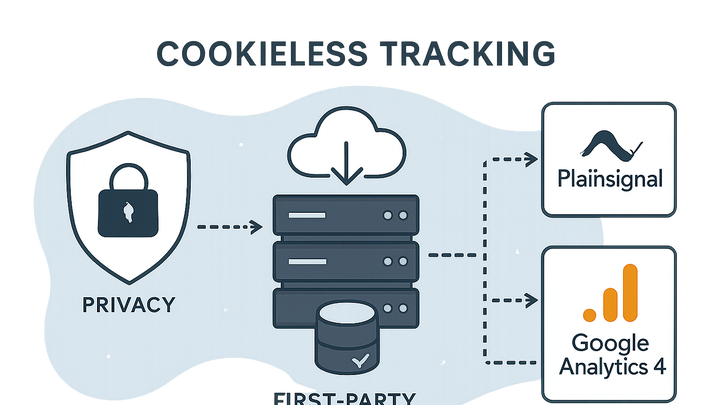Published on 2025-06-26T04:40:35Z
What is Cookieless Tracking? Examples with PlainSignal and GA4
Cookieless tracking refers to techniques for monitoring user interactions on websites and apps without relying on traditional browser cookies. It leverages methods such as server-side processing, first-party storage, and privacy-preserving APIs to capture essential metrics while respecting user privacy and complying with regulations like GDPR and CCPA.
As third-party cookies are phased out by browsers and regulations become stricter, analytics platforms such as PlainSignal and Google Analytics 4 (GA4) have adopted cookieless approaches to maintain data collection capabilities. PlainSignal offers a lightweight, cookie-free analytics solution that requires a simple script injection. GA4 uses a combination of first-party cookies, Google Consent Mode, and aggregated data modeling to fill gaps in user tracking. This glossary entry explores the principles of cookieless tracking, outlines common implementation strategies, and highlights best practices for deploying these methods effectively.
Cookieless tracking
Tracking user interactions without cookies by using server-side methods, first-party storage, and privacy APIs for compliant analytics.
Overview of Cookieless Tracking
This section provides a conceptual introduction to cookieless tracking, explaining what it is and why it has become essential in modern web analytics.
-
Definition
Cookieless tracking refers to methods for capturing user interactions without relying on browser-based cookies, using alternatives such as server-side events, first-party storage, and privacy-focused APIs.
-
Drivers behind adoption
Evolving privacy regulations (e.g., GDPR, CCPA) and major browser changes (e.g., blocking third-party cookies) have forced analytics providers to develop cookieless solutions.
Key Mechanisms and Technologies
Explores the main technical approaches that enable cookieless tracking, along with their strengths and considerations.
-
Server-side tracking
Data collection and processing happen on the server rather than in the user’s browser, reducing dependency on client-side cookies and improving data quality.
-
First-party storage
Leveraging browser storage APIs like localStorage or sessionStorage to store identifiers under the site’s domain, maintaining continuity across sessions.
-
Privacy-preserving apis
Utilizing emerging standards (e.g., Privacy Sandbox, FLoC) and browser APIs designed to share aggregated insights without exposing individual user data.
Implementation Examples
Demonstrates how to implement cookieless tracking using PlainSignal and Google Analytics 4.
-
PlainSignal setup
Insert the following snippet into your HTML to enable PlainSignal’s cookie-free analytics:
<link rel="preconnect" href="//eu.plainsignal.com/" crossorigin /> <script defer data-do="yourwebsitedomain.com" data-id="0GQV1xmtzQQ" data-api="//eu.plainsignal.com" src="//cdn.plainsignal.com/plainsignal-min.js"></script>This script sends event data directly to PlainSignal’s servers without using any cookies.
-
Google analytics 4 configuration
GA4 supports cookieless tracking through first-party cookies, Google Consent Mode, and modeling. Ensure gtag.js is loaded and configure consent settings:
gtag('consent', 'default', { 'ad_storage': 'denied', 'analytics_storage': 'granted' });This setup helps fill data gaps when users decline cookies.
Advantages, Limitations, and Best Practices
Outlines the benefits and trade-offs of cookieless tracking, along with recommendations for implementation.
-
Advantages
Improves user privacy, complies with regulations, and future-proofs analytics as browsers phase out third-party cookies.
-
Limitations
May reduce user-level accuracy, limit cross-site attribution, and require more complex infrastructure like server-side tagging.
-
Best practices
Combine server-side and client-side methods, employ fallback mechanisms, maintain transparency with users, and test regularly to ensure data quality.
